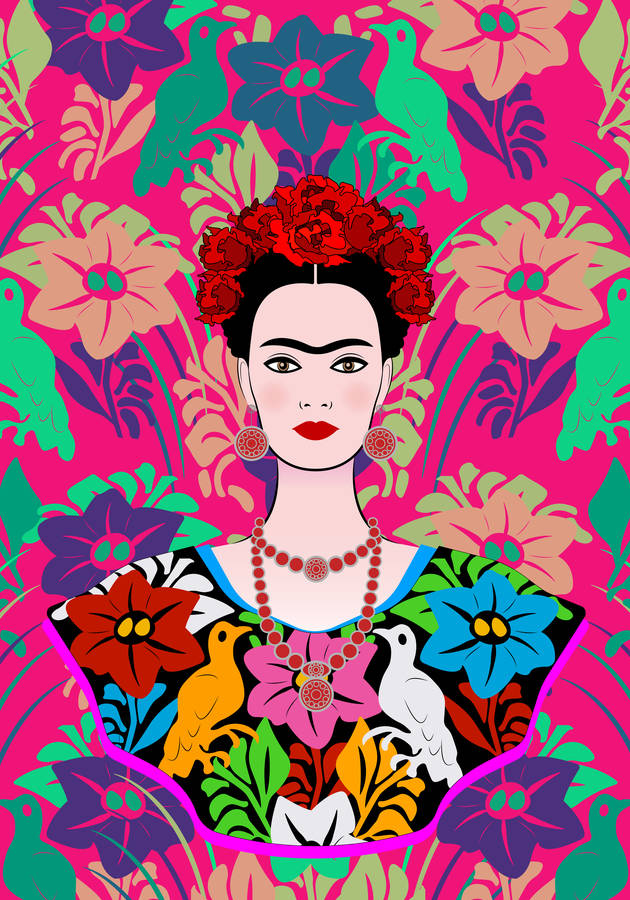Frida Kahlo, one of the most significant artists of the 20th century, loved only three things in life: Diego Rivera, painting, and communism. A few extramarital affairs aside, she knew how to remain enthusiastically faithful to all of them, becoming a legend in the process. And just like all legends, hers too starts with an innocuous lie.
Frida, a child of the Mexican Revolution
In 1910, a month after Mexico celebrated the centennial of its independence from Spain, an armed revolt broke out in the country. It began with a call to arms by unjustly jailed presidential aspirant Francisco Madero to oust Mexico’s longtime dictator Porfirio Díaz, and it ended ten years later with a new constitution that democratized the country and swept in major labor and land reforms.
These were the days of Pancho Villa and Emiliano Zapata, an age of bloodshed and chaos, a decade of heady dreams and unblemished ideals. A dreamer and idealist herself, many years later, Frida Kahlo would choose 1910 as the year of her own birth. She believed that, just like her country, she too was a child of pain, blood, and life-affirming energy – so she decided that she and modern Mexico must have been born together.
Suffering artists at the Blue House
Kahlo’s birth certificate doesn’t corroborate her story. It says she was born at 8:30 in the morning on July 6, 1907, in the Coyoacán suburb of Mexico City – most likely at the very same place where she would die 47 years and seven days later: “La Casa Azul,” The Blue House. A beloved family home, the house was built just three years before by her father, Guillermo Kahlo, a German Hungarian immigrant and a successful photographer with occasional government commissions; her mother, Matilde Calderón, was a devout Catholic of Mexican Indian and Spanish descent.
Guillermo – an epileptic with frequent seizures – felt particularly attached to Frida. He would often remark that, of his six daughters (two from a previous marriage), she was the most intelligent one and the one most resembling him in character. Not particularly intimate with his other children, Guillermo incessantly stimulated Frida’s adventurousness and unconventionality. He encouraged her to read German poets and explore nature, to swim, play soccer and wrestle, and – to the dismay of his wife – he even allowed her to cut her hair short and wear boys’ clothes. The two grew even closer after Frida was stricken with polio at the age of 6: they were suddenly bound not only by their intellectual curiosity but also by a shared experience of illness and loneliness.
Anarchically happy with the Cachuchas
In 1922, when she was 14, Guillermo sent Frida to the National Preparatory School, the best educational institution in Mexico. Her mother found this outrageous and inappropriate since it made Frida one of only 35 females in a student body of some two thousand. Not that it showed: irritated by the girls’ endless gossiping and pettiness, Frida spent all of her time with her male classmates.
She was a prominent member of several cliques and groups at the Preparatoria, most notably the Cachuchas, named after the peaked cloth caps they wore as a sign of subversion against the rigid dress code of the period. The Cachuchas were famous for their intellect and irreverent attitude toward customs and norms. “We were anarchically happy,” remembered one of the group’s members in his memoir decades later. “We spent our ingenuity writing verses, lighting rockets, and studying in our own way.”
When they were not fiercely debating Kant, Hegel, and Marx, the Cachuchas played practical jokes. Some of their favorite early targets were a group of artists hired by the government to paint murals of national heroes on the walls of the school. One of them was Diego Rivera, an overweight, immensely charismatic 36-year-old painter of world stature.
The Mexican Renaissance
Fourteen years before, Rivera left Mexico City to perfect his artistic style in Europe. There, he met most of the leading avant-garde artists of the age, including Modigliani and Picasso. His paintings had just begun to attract the attention of European museums when the revolution triumphed in his home country. To promote its ideals among the largely illiterate population, the new government introduced a mural program, calling home Mexico’s best painters to cover the walls of schools, churches, and museums with vast frescoes that depicted subjects drawn from ancient and modern Mexican history.
The program started a cultural revolution – later named the Mexican Renaissance by a prominent art critic. Together with José Clemente Orozco and David Alfaro Siqueiros, Diego Rivera was one of its three unofficial leaders. His larger-than-life persona attracted Frida Kahlo almost immediately after she first noticed him, perched on a scaffold in the Preparatoria’s auditorium. Soon after, she reportedly told some of her friends, “My ambition is to have a child by Diego Rivera. And I’m going to tell him so someday.”
The accident
Unfortunately, at least for the time being, life had some very different plans. On September 17, 1925, on her way home from the preparatory school, Kahlo was involved in a bus accident that nearly killed her. Frida suffered many injuries. Her spinal column was broken in three places, her right leg in eleven. Her left shoulder was severely disjointed, and several of her ribs were cracked. A steel iron handrail impaled her body at the level of the abdomen, crushing her pelvic bone and coming out through her vagina.
The injuries were so severe that, for a month, no one knew if she would survive. The doctors had to put her body back in sections as if making a photomontage. As a result of the accident, Kahlo would undergo 32 separate surgical operations in her lifetime. “I hold the record,” she joked in a 1950 interview for Time magazine.
From 1925 on, Frida’s life was a grueling battle against slow decay. “She lived dying,” said one of her closest friends. Before the accident, Kahlo had been a gifted student with an interest in medicine and a penchant for doodling in her notebooks. The prolonged inactivity that followed her accident turned this penchant into a vocation. Confined to her bed in a plaster corset, she began to paint self-portraits with the aid of a mirror placed above her head. She would continue to do so throughout her life. Of her 143 paintings, more than a third (55) are self-portraits, most of them incorporating symbolic depictions of physical and psychological scars. “I paint myself,” Kahlo said in an interview later in her life, “because I am so often alone and because I am the subject I know best.”
The Elephant and the Dove
It is certainly difficult to think of a more introspective modern painter than Kahlo. “Frida is the only example in the history of art of someone who tore out her own breast and heart to tell the biological truth of what she feels in them,” once wrote Diego Rivera – the man Kahlo would later describe as the second “grave accident” in her life.
The two met six years after Frida vowed to one day have Diego’s children. It happened at a party given by a mutual friend, Italian photographer, model, and communist activist Tina Modotti. Rivera immediately recognized Kahlo’s talent, calling her the most original painter in Mexico. The next year, on August 21, 1929, the two married; Rivera was 43, and Kahlo 22. The move wasn’t approved by her parents, who described it as “a marriage between an elephant and a dove.” To make matters worse, Rivera was a notorious womanizer who had just divorced his second wife and already had three children.
Even though Rivera continued to chase women (including Frida’s younger sister) and Kahlo retaliated with several affairs of her own (both with men and women), their admiration and support for each other’s work rarely waned, and their lives remained intertwined until the very end. Not even a 1939 divorce separated them: they remarried the following year. When Frida died in 1954, Diego didn’t want to believe she was dead. Almost immediately, he became an old man, pale and ugly, a soul cut in two. He died just three years later.
Gender and art
Despite Rivera being the most celebrated Mexican artist of the age, Kahlo never fell under his artistic influence, finding her way outside the dominant, masculine style of mural painting through her astonishingly personal and intimate self-portraits. Unlike her husband, Frida wasn’t interested in epic revisions of Mexican history or grand statements on the evolution of the human spirit. Instead, her work reflected the impressions of her childhood, of Mexican folk art, and of the tiny, descriptive ex-votos that hung in the Catholic churches and told stories of people who had been saved by miracles.
Most of all, it reflected her struggles with the sufferings of life: while Rivera wanted to fashion a new world through his majestic murals, Kahlo merely wanted to fashion a new self. Painting herself bleeding, weeping, cracked open, she transformed her pain into art with remarkable honesty, tempered by humor and fantasy. Art seemed to give her what life rarely did. “From the time of the accident,” she explained on one occasion, “my obsession was to begin again[…] Thus, as the accident changed my path, many things prevented me from fulfilling the desires which everyone considers normal, and to me, nothing seemed more normal than to paint what had not been fulfilled.”
A self-created surrealist
For most of her life, Frida believed that her paintings were “small and unimportant” and too personal to appeal to anyone but herself. But early in 1938, at Rivera’s urging, she submitted four paintings to a group show in Mexico City. To her surprise, her work began to attract attention. “She is an excellent painter, of real originality, one of the most interesting Mexican artists I know,” wrote an art critic. “Her work looks well beside the best pictures of Orozco and Rivera; in some ways, it is more natively Mexican than theirs.” It was in April of the same year that the leader of the European surrealist movement André Breton first met Kahlo and saw her paintings. He was taken both with her and them. He proclaimed Frida a self-created surrealist and later described her art as “a ribbon about a bomb.”
Even though Kahlo disdained Breton, he became an avid promoter of her work. He encouraged New York City gallerist Julien Levy to show Frida’s first – and only – solo exhibition in the United States at the end of the year. Approximately half of the paintings were sold, four of them to Hollywood icon Edward G. Robinson. At the beginning of the following year, a few of Frida’s paintings were displayed in Paris as well. One of them, “The Frame,” was acquired by the Louvre, making Kahlo the first 20th-century Mexican artist to be included in the museum’s collection.
The last exhibition
Kahlo didn’t care particularly much for any of this. A dedicated communist (she and Rivera even received Leon Trotsky for two years during his exile from Stalin’s Soviet Union), Frida found the Americans dull and dumb, and the capitalist way of life – repugnant. The parasitic existence of the Parisian artists made her vomit. Although most of her admirers were in the United States and Europe, she longed for Mexico, where she returned for good after her second marriage with Rivera at the end of 1940. The couple moved into Frida’s childhood home, where she continued to be productive during the next decade, in spite of failing health and a growing addiction to alcohol and painkillers.
In April 1953, when it became clear that Kahlo didn’t have a lot more to live, her friends staged a showing of her paintings in Mexico City’s Gallery of Contemporary Art. It was her first solo exhibition in her beloved home country. She was bedridden at the time, but she still showed up, carried on a hospital stretcher. It was yet another act of defiance against fate, another display of Kahlo’s indomitable spirit and love of life. She carried it proudly – to the very end.
Viva la vida
Soon after her leg was amputated in August 1953, she drew a sketch of her feet on a pedestal. Underneath, she wrote: “Feet, what do I want them for if I have wings to fly?” On July 2 of the following year, she disobeyed her doctor’s orders and joined Rivera in a communist demonstration against the CIA invasion of Guatemala. Just three days later – and merely a week before her death – she completed her last painting: a still life of ripe watermelons. Across the pulp of the foremost slice, and just above her name and the date, Frida inscribed, in large capital letters, her final salute to life: “Viva la vida.” Long live life.
Sources
Main
- Hayden Herrera, Frida: The Biography of Frida Kahlo (London: Bloomsbury Publishing, 2018).
- Claudia Schaefer, Frida Kahlo (Greenwood Publishing Group, 2009).
- Alicja Zelazko, “Frida Kahlo,” Encyclopedia Britannica (November 8, 2019). [https://www.britannica.com/biography/Frida-Kahlo]
- Amy Stechler, The Life and Times of Frida Kahlo (PBS, 2005).
Other
- Robert M. Buffington, “Kahlo, Frida,” Mexico: An Encyclopedia of Contemporary Culture and History, pp. 249-251.
- Dulce Aldama, “Kahlo, Frida,” Encyclopedia of Latino Popular Culture, Vol. I (Greenwood, 2004), pp. 401-403.
- H. H. Arnason, and Elizabeth C. Mansfield, “Social Protest and Personal Pain: Mexican Artists,” in History of Modern Art (Pearson, 2013), pp. 364-368.
- James Oles, “Frida and ‘Los Cachuchas,’” Instituto Tlaxcalteca de la Cultura (2018). [https://artsandculture.google.com/exhibit/frida-and-los-cachuchas-instituto-tlaxcalteca-de-la-cultura/ZAISwv-IPqasIw?hl=en]
- Lenny Ann Low, “Frida Kahlo the icon,” The Sidney Morning Herald (May 25, 2016). [https://www.smh.com.au/entertainment/art-and-design/frida-kahlo-the-icon-20160521-gp0l9e.html]





























